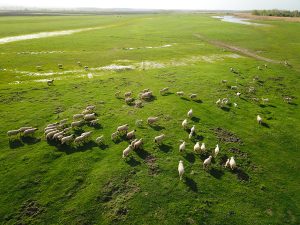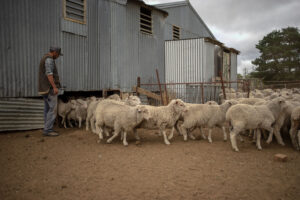Vegetable matter (VM) levels wax and wane each year on a fairly regular seasonal pattern, reaching lows around Christmas and highs toward the middle of the calendar year. The levels reached vary between years and it is this variation that is associated with differences in discounts for VM. This article takes a look at VM levels in the clip and where they are likely to go in 2023.
Vegetable fault (VM) is starting to pick up, which is normal for this time of the season. Figure 1 shows the monthly average VM level for Eastern and Western Australia from the mid-1990s to this month. The seasonal rises and falls in the VM levels stand out with some seasons being much higher and some seasons much lower. As a rule, VM in Western Australia is lower than in the east, but as with most such rules, there have been exceptions for short periods. The VM level has kicked up this month (to date), which in the east is off a relatively high base whereas, in the west VM, levels are somewhere near normal.
We know from the seasonal pattern that VM levels rise into the middle of the calendar year, and seasonal conditions have been good for the past three springs in eastern Australia which should help boost VM levels in 2023. To model the VM level in the eastern clip pasture growth rate (PGR) data from the Long Paddock website https://www.longpaddock.qld.gov.au/ has been used. Monthly regional estimates of PGR have been weighted for wool production to arrive at a proxy for pasture conditions. The year-on-year change in the eastern PGR rolling 12-month percentile rank (using a lookback period of 40 years) was then compared to a VM level (in the case of Figure 2 it was the proportion of the eastern clip which had a VM level of 5% to 6%) and a simple model developed. The model provides some short-term forecasting as it lagged by 6 months against the wool sale data.
Figure 2 compares the proportion of wool with 5% to 6% VM sold with the model developed, using data from the past decade. The model is not a perfect one, but it does give an idea of when the VM level should be higher or lower than normal and provides that 6-month forecast, which can be extended by using historic PGR levels. The model indicates the proportion of 5-6% VM wool will jump back to levels consistent with 2017 through 2019 which is fairly high. The implication is that discounts for VM will increase again as the supply chain struggles to absorb the increased supply of higher VM.
What does it mean?
VM is one of many factors which influence greasy wool prices. When the level of VM is low in the clip, typically in December/January, it is not a great influence on price. By the mid-calendar year, this changes as VM becomes an issue for mill consignments trying to meet a 1% VM average, especially in years where VM is relatively high as it is going to be again in 2023. Discounts for VM have a high probability of increasing from now on.
Have any questions or comments?
Key Points
- VM levels in both eastern and Western Australia have started to rise, in line with seasonal patterns.
- In the east, the base level has been relatively high, and modelled projections indicate we will see high VM levels from the autumn onwards.
- Discounts for VM are likely to widen as a consequence.
Click on figure to expand
Click on figure to expand
Data sources: AWEX, Long Paddock, ICS, Mecardo














